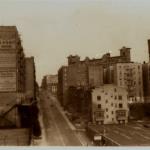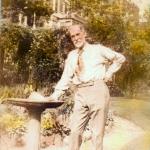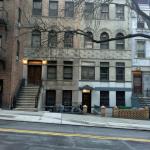 | ||||
 | ||||
West 158th Street
(click to enlarge)
 | ||||
After wandering for some hours,
I turned into a rustic road which led directly down towards the river. A noble forest was planted on the one side of it, and on the other vast grain fields lay laughing in the sun...my walk soon brought a secluded country house into view...
Parke Godwin
Homes of American Authors
1842
It consisted of forty-four acres, all heavily wooded, and at that time was almost as remote from the city as a lodge in the Catskills.
Rufus Rockwell Wilson
New York Old and New
1902
Sixty-five years ago the upper part of Manhattan Island was still wood-land, as wild almost as the Southern savannahs, or the unpeopled prairies of the West...into this quiet and beautiful land in search of a retired home wandered Audubon, the naturalist, one of the great men of the world.
M. E. Audubon
Audubon's Granddaughter
New York Times
April 30, 1905
But, the labor of writing his Ornithological Biographies and of over-seeing the printing of the plates of his great work had for some years confined him to cities, and with the completion of the publication of The Birds of America, he felt that he must have a home in the country.
George Bird Grinnell
Audubon Park
1927
West 158th Street
You may want to cross to the northern side of the street so that as you walk down West 158th Street, you have a bit of perspective on the row of twelve houses. Just past the three garage doors, you'll see a series of windows and a black metal sliding door, which mark the site of the "ballroom in a basement" at the rear of 807 Riverside Drive. With a separate entrance on 158th Street, the room was popular as a meeting place for local art and music groups, but rarely used for social events such as dances.
Next, you'll come to twelve row houses that represent the first wave of “subway boom” residential construction: housing for the expanding population that developers anticipated would migrate to northern Manhattan following the development of New York City’s rapid transit system. These twelve houses were constructed in two phases between June 1896 and June 1898 and were the first permanent structures built on the site. In contrast to the spacious villas set into Audubon Park’s sloping topography, these houses were aligned with the grid on regular-sized city lots.
Architect John P. Leo designed and built the first eight houses, beginning at the western (far end) of the block. He then designed four more houses that John Lilliendahl built for the eastern end of the row, adjacent to the Soulard-Miller house, which was still standing then. Leo had bought the land for his houses from architect August W. Cordes, who then bought # 634. With Theodore de Lamos, Cordes designed the Armeny Building, Fulton Building (130 Fulton Street), and Macy's Department Store in Herald Square.
These houses represent an interesting owner-negotiated solution to urban planning. In 1896, Isabelle (Mrs. John P.) Leo and the Grinnell family, Audubon Park’s major landholder, signed a covenant for “increasing the value of their respective properties and improving the character of the neighborhood.” It established fourteen-foot setbacks and limited construction to single-family dwellings “of brick or stone, not less than three stories in height” until January 1, 1910. Had that covenant not been in effect, the block’s character could have been significantly different.
The most famous resident of this row was Reginald Pelham Bolton, called the “no. 1 Citizen of Washington Heights” in his New York Times obituary. An engineer, historian, writer, amateur archeologist, and neighborhood activist, Bolton bought #638 from Isabelle Leo in September 1897and lived there until his death in February 1942. Bolton. who had tried to save the Audubon house, was an early proponent of historic preservation and served as Vice President of the American Scenic and Historic Preservation Society, New York’s first organized preservation lobby.
Bolton’s son Guy achieved an global fame as the writer of novels, stage adaptations, screenplays, and more than 50 plays and musicals in collaboration with the Gershwins, Cole Porter, and P.G. Wodehouse.
Reginald Pelham Bolton
(click to enlarge)
158th Street circa 1930
(click to enlarge)
Continue your walk . . .
Funded by the Audubon Park Alliance


